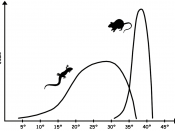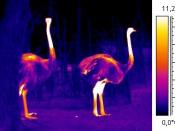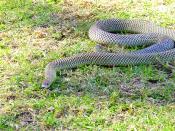Red Kangaroo: Macropus Rufus
The Kangaroo is an endotherm. Endotherms generate heat from their body's metabolism. So their internal body temperature is independent of the external temperature. Endotherms eat more food than ectotherms. This higher food intake results in an increased level of metabolism, which is required to produce heat.
The Red Kangaroo inhabits inland plains throughout Australia. They prefer open plains where trees and bushes are scarce.
The fur on Kangaroos maintains an insulating layer of trapped air that slows down heat exchange with the environment. The thickness of the air layer can be increased in cold conditions by contracting muscles that lift the fur away from the skin.
Adaptations to the cold include increased metabolic processes, shivering and sun basking. Metabolic processes generate heat and keep the body warm. Shivering increases muscle activity and produces heat and basking in the sun also keeps the body warm.
In hot conditions Red kangaroos seek shelter from the sun to escape high temperatures.
Kangaroos also lick their forelimbs where the blood vessels run close to the surface of the skin and heat is lost from the body. The evaporation of the saliva is thought to have a cooling effect. The light colour of the fur reflects heat, panting and sweating also help to keep the kangaroo cool. However, since their body is covered by fur kangaroos have a limited ability to sweat, and rely heavily on panting to increase evaporation of water across the moist surface of the tongue. The posture of the red kangaroo with the tail pulled into the shade of the body minimises the surface area exposed to the sun this minimises the amount of moisture lost.
Since enzymes have strong temperature preferences, usually around 37&úC, their efficiency is reduced outside their preferred ranges. Kangaroos have a...


